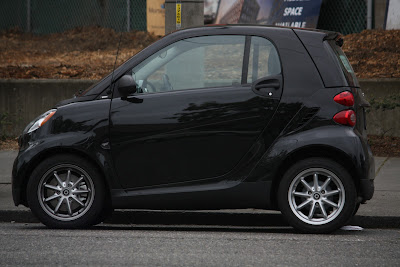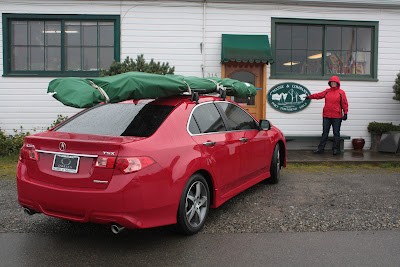The fact that Carol Hasse makes some of the best cruising sails in the world was just icing on the cake.
So we walked into her place back in August. After a bit of a tour, we agreed to get a quote. It wasn't cheap but, we could make the plan work and, with that, we put down our deposit. A personal visit by Carol a short while later for the measurement, some back and forth on when the sails would be made, and we had a schedule.
The plan was to have the sails (mainsail, staysail, and genoa) made in stages. This way we could pay cash for each sail. It was important to us to not buy our sails on credit. This worked out great.
So the main came due. Since the sail is a full batten main, it can't be folded up into a small package. It's in a fifteen foot long bag o'sail. This presented a problem. We have a small car. We call her Smarty.
Smarty is only nine feet long. Smarty has no roof rack, nor any way of mounting one. While Smarty always wins the parking lottery in Seattle, she has only two seats and a limited cargo carrying capacity. But, we have had her for two years and like her for many reasons. She's fun to drive, and you can enjoy roaring around town while people point, smile (sometimes laugh) at the car. However, as I mentioned, Smarty has no roof rack.
So the plan was to get a Zipcar, specifically a Ford Escape with a roof rack. I was going to lash a 19' long windsurfer mast to the rack and the sail bag to that.
We wake up Saturday morning to a nail in the rear tire of Smarty. This requires a trip to the dealer for a repair as Smarty has odd tires and my warranty is with the dealer. I get there and the dealer is not open for about 45 minutes. This frustrates me. I ask the kindly Acura employee if we can get some coffee in their shop next door while we wait.
So, step one to getting a new mainsail for Brigadoon involved getting a new car.
Witness the new Acura TSX Special Edition. Smarty is on to a new home and we have a new ride, with a roof rack, that compares favorably with my old BMW Z4 in performance and comfort. I think we will be very happy with it.
Today we finished installing the Strongtrack on the mast for the new sail, along with completing a rig tune. There is still some fine tuning to do on the rig (the mast has a small "wiggle" in it) but we were ready to go, so, time to bend on the new main.
And here it is: a Carol Hasse designed and Port Townsend Sails built, cruising mainsail, complete with deep reefing, cunningnam, full battens and a host of other really awesome hand done features.
I'm so far, very happy with how absolutely beautiful this sail is. It fits the boat wonderfully. I bet it sails as well too.
In a month, we get the genoa, then June the staysail.
I can't wait to see how well Brigadoon performs with the new suit of sails.








